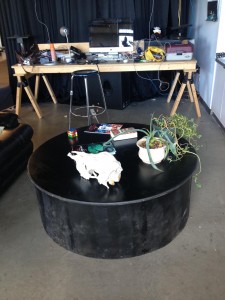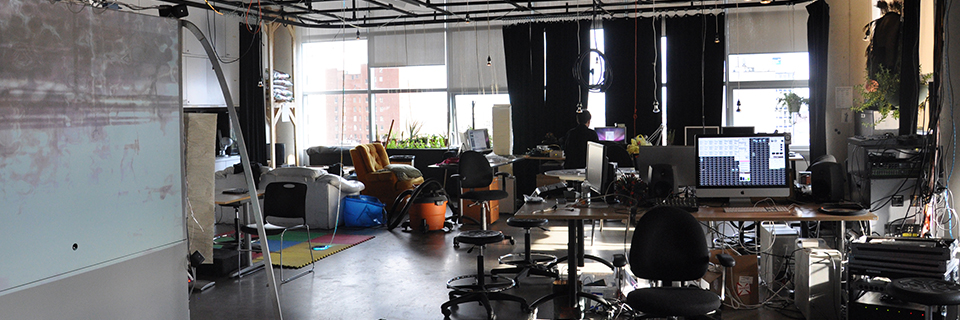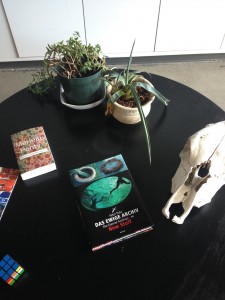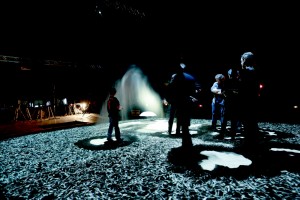The Media Lab as Space for “Play and Process”: An Interview with TML’s Navid Navab
The point is to build environments that are “not complicated but rich.” At the TML, we live with our designs, within our responsive environment.
Interview with Navid Navab
Associate Director in Responsive Media, Topological Media Lab
Research-Associate, Matralab
Multidisciplinary Composer
The Topological Media Lab (TML) is a large, open space with polished concrete floors and a long wall of windows punctuated by various hanging plants and black-out curtains. The room is canopied by a maze of light bulbs, microphones and wires that dangle from the tall ceiling, all of which goes unnoticed if your eyes are preoccupied with the other strange and wonderful objects that inhabit the lab – on one low coffee table, a deer skull sits nonchalantly next to a Rubik’s cube and Merleau-Ponty’s Phenomenology of Perception.
The first time I attempt to locate the TML, I find myself wandering through the shiny halls on EV 7, pondering the chaotic numbering systems of the future. Lucky for me, Navid Navab – multidisciplinary artist, “media alchemist,” thinker/maker – embraces chaos (and knows these halls well). Navab, who is also Associate Director in Responsive Media at the TML, kindly fetches and leads me to room 7.725, the space where he works, researches and creates. We speak at length about the design and philosophy of the lab, as well as the various projects that have been explored there, and are eventually joined by Michael Montanaro, co-director of TML and chair of Contemporary Dance at Concordia. The conversation is both delightful and at times mystifying. I begin to jot down terms like “gesture bending” and “subjectivation,” planning to Google them later…

The dance/new media projects that have emerged out of TML are what first piqued my interest in the lab. The “Shadows and Light” sequence in TML’s Einstein’s Dreams (2013) presents a space in which performers interact with media as they move through the space, “dragging” pools of light with their bodies as they dance. Another example is performer/creator Teoma Naccarato, whose past research with TML has contributed to her practice, which integrates contemporary dance with interactive video, as well as audio and biosensor technologies to navigate material and virtual scenarios.
Several weeks after speaking with Navid and Michael, I decided to ask a few more questions, via email. Navid’s writing style is almost identical to his mode of speaking; he meanders deftly and with charm between topics as diverse as teamwork, dance improvisation, operating theatres for surgeons, grant-writing and Felix Guattari. Because of this, I’ve provided a glossary of terms at the end of the interview to help readers navigate.
Here’s what Navid had to say:
HB: What is the Topological Media Lab?
NN: The TML (Topological Media Lab) was established in 2001 as a trans-disciplinary atelier-laboratory for collaborative research-creation. In 2005, TML moved to Concordia University’s Hexagram research network. Following the departure of the founding director Sha Xin Wei in 2013, the TML was restructured to sustain as an autonomous laboratory for the critical study of media art and sciences at Concordia University.
As articulated on our website, TML’s projects serve as case studies in the construction of fresh modes of knowledge, bringing together practices of speculative inquiry, scientific investigation and artistic research-creation. Currently, TML’s technical research areas include: responsive environments, active media, computational-materials, and gesture bending. Its application areas lie in movement arts, speculative architecture, and experimental philosophy.
The TML is both an atelier and a laboratory for research in improvisatory gesture from both humane and non-anthropocentric perspectives. Our atelier research investigates the process of subjectivation, agency and materiality from phenomenological, social and computational perspectives. It approaches this by suspending assumptions about what we think are egos, humans, machines, objects, and subjects. Instead, we consider the transformations of things, and see how these things emerge through play and process. This method is informed by a continuous (rather than tokenized object/grammar-based) approach to material change, hence the “topological” aspect. Topology is concerned with the non-metric (non-numerical) properties of space and the continuous, dynamic relationships through which space is constituted.
HB: How did you originally become affiliated with TML?
NN: I first become affiliated with the TML in 2008 as a curious student — occasionally dropping in, apprenticing with inspiring thinker-makers — and shortly after as a core artist-researcher and co-author of projects. I was given sufficient autonomy to freely innovate my own voice and in a few years I was initiating and leading multiple research streams of my own. Each research stream would investigate a particular question or phenomenon that interested me, which I would explore through organized discussions, intensive material-computational research-creation, and eventually through live experiments, workshops, engineered software environments, published works of art, and peer reviewed publications. The studio-lab supported these diverse activities both intellectually and logistically, thus enabling my pursuit of passionate and radically fresh art-research without having to constantly defend these investigations in institutional language (e.g. of disciplines, granting agencies) or in terms of the market.
Over the years my activities have enriched and shaped the environment of TML, leading to my role as Director in Responsive Media, in collaboration with the lab’s current co-director Michael Montanaro.
HB: How many other people are involved regularly at TML?
NN: TML welcomes curious passersby to drop in and engage with its ecology of practice. TML’s long-term research-experiments are driven by a small group of 6 or 7 actively present members: directors, administrators, core artist-researchers, and research-assistants. We are also in constant exchange and collaboration with our international partners at top institutions and centres around the world. Additionally, TML hosts a continually shifting and returning array of newbies, apprentices, students, artists in residence, visiting scholars, international partners, artists and hackers.
HB: What are the practices that happen at TML on a daily basis? How does knowledge emerge out of the TML and what is the material form of that knowledge?
NN: Practical domains for art research at TML are:
theory: imagine, make, explore, articulate and evaluate concepts rigorously
art: ethical-aesthetic gesture and creative ways of being with others
technique: (for) collective innovation, improvisation, and play
The TML stores group knowledge, an apparatus structured by ongoing experiments, from which members take what they need in order to make experiments, and to which they contribute pieces that others can use in the future. The apparatus is made up of various components such as physical things, material samples, software, documentation, videos, reports and procedures.
The TML is not a production facility for individual art projects.
It is a place for building sketches and experiments with larger ambition for impact, and which requires the collective talent, expertise, and energy of a small team. The TML is a nexus for art-research (neither art production nor technology development) with a family of themes with philosophical or critical value such as:
– ethico-aesthetic play
– distributed agency
– materiality
– gesture and movement
– phenomenology of performance
– critical studies of media arts and sciences
These themes are elastic and have evolved over the years around the joint interests of an affiliate community of artists, researchers and philosophers who engage with the lab. These themes also take material form, as works of art, performances, engineered instruments or systems, essays, peer-reviewed papers and documentary videos.
Besides making stuff and overseeing research experiments, we also situate TML’s activity within the contemporaneous global context, and locate funding for our affiliate researchers so that individual members can pursue their work with more autonomy and freedom. In exchange, we expect work of world class quality (not student class project work) which should aspire not merely to tech art venues (such as Ars Electronica), but also to real world, socially embedded situations.
HB: How does the material space of TML affect the products and processes that occur within the lab?
NN: Some of TML’s experiments use active lighting and acoustic conditioning systems to change the apparent physical qualities of interior or exterior space. The point of this work is to build environments that are, to quote Xin Wei Sha, “not complicated but rich.” The TML space was designed from the ground up by the founding members, Sha Xin Wei and Harry Smoke, to handle demanding and diverse sets of events and technological structures. The configuration of the space is itself continually shaped under ongoing research. At the TML, we live with our designs, within our responsive environment. Our research-creations are thus always put into unscripted play and place. This approach results in responsive designs that at once address everyday functions, inform ambient aesthetics and enable virtuosic improvisations, all within one holistic, responsive environment — the TML itself.
Our designs and concepts are not invented in a “black box” and they are not made with black-boxed technologies; they are co-articulated through TML’s ongoing dynamic and spatial apparatus that is never turned “off”: a responsive environment full of rich contingent activity.
Therefore, the space at TML is itself a live apparatus for enacting knowledge in a collective fashion. Projects conducted in the atelier draw on and also contribute to ongoing research in the computational and natural sciences, seeking to understand the dynamic interplays of social, psychical and material space.
(Consider Navab’s delightful description of the “ecology” of the Topological Media Lab in the imagined scenario below)
…a visiting person’s shy manner of walking into TML gently perturbs our responsive ecology—very much the same way a lost traveler’s careful steps in an autumnal forest perturb the surrounding life, resulting in fields of distributed activity. A few researchers and artists are busy making stuff and a group of people at the far corner of the lab are participating in a seminar. Through the responsive environment, the inhabitants of TML are gently made aware of a different-presence in the lab and yet this awareness—this ambient behavioural resonance—does not cost their full foci of attention. One research assistant walks to the new comer to welcome them into the space….
HB: What is the difference between the Topological Media Lab and the other space where you are affiliated, the MatraLab?
NN: TML and Matralab occasionally collaborate on projects, share talent and often support each other in large-scale initiatives. Despite their partnerships and similarities, the two labs are however completely independent of one another, each with their very particular and unique vision, process and agenda. Matralab is a research space of inter-x art directed by Sandeep Bhagwati, “dedicated to using interdisciplinary art practice to bridge the gap between emerging art forms and their aesthetic reflection.” Matralab’s core activities revolve around experimental musical events, and comprovisational environments to name a few. Matralab’s research is leading to the establishment of a practical and theoretical framework for the creation and evaluation of interdisciplinary, intercultural, intermedial and interactive art.
HB: How important is dance/movement to the work done at TML? I know you work with dancers regularly – can you talk briefly about what it’s like to collaborate with dancers?
NN: One of TML’s strategic goals is to transpose insights from movement and performance into the design of durable, everyday situations, and experimental environments. We leverage our pre-verbal intuition of physical materials and embodied knowledge to explore the ways in which bodily relations are felt and understood. For example, we do experiments that explore when movements can be regarded as volitional rather than accidental, and when movements—perhaps among multiple bodies and things—can be regarded as a single gesture. The emphasis is often on continuous, unanticipated movement that may be improvised freely by those within the conditioned space.
Our ongoing GestureBending* experiments explore how everyday gestures can become charged with symbolic intensity and used for improvised-play.
Close collaborations with dancers and performers are extremely unique and precious opportunities for rigorous co-creation, refinement, and embodied evaluation of gestural media and responsive environments.
What is evaluated is the media/matter/environment’s potential for play—in its ability for allowing boundlessly open sets of a priori gestures and experiences by the participants to acquire expressive, playful and poetic force. If successful, participants’ gestures not only lead to unexpected meaning and instrumentality but to narratives about and recognizing daily life and the material world as a platform for play and for refined practice. Such a design approach allows for any potential movement at all by the participants to turn into a potentially co-expressive art-event. This removes the burden of modeling the human experience through mimetic performativity and instead allows for such notions as gestural meaning, intentionality, expressivity, noise, musicality, and even performer, performed and spectator to freely arise from the context established in the moment of performance.
So in a sense—to maximize improvised co-expressivity and synergetic play— it is helpful for performers to unlearn presumptions about what it means to interact with responsive media and instead maneuver embodied intuition, to improvise gestures as they already always have in continuous media like fabric, flesh, water, air, and mud. When designing performative media (an installation, instrument, or a responsive scenography), even when rigorously staging theatrical events with virtuosic performers, who are welcome to incorporate or invent their own very unique sets of gestural vocabularies, we maintain the position to never model or presume, at least in our design metaphors, what constitutes a gesture or a body. We condition performative events that potentialize improvised play, always working with a priori non-anthropocentric movement and contingent activity. Therefore solo dancers, groups of passersby, and even non-humans objects and subjects are all treated (computationally and conceptually) as fields of stuff and process. Within this continuously responsive field—fusing humans, non-humans, media, matter, and energy— solo dancers as well as other (non)human performers can improvise nuanced gestural expressions, co-constituting and enacting one another in the ever-changing field that forms them!
At TML’s recent GestureBending workshops, resulting from my ongoing collaboration with expert dancers, participants discovered that their everyday movement can create intricate sonic textures and developed their own unique vocabulary of sound generation to sculpt musical events via intuitive movement and embodied engagement with computationally enchanted materials. Leveraging the GestureBending apparatus, renowned TML performance works such as Practices of Everyday Life | Cooking symbolically charge everyday actions and objects in ways that combine the composer’s design with the performer’s contingent nuance.
What we are suggesting is a holistic shift from representational technologies to performative media, from nouns to verbs, from objects to fields of matter-in-process, from a priori concepts to processes that enact concepts. To adapt Mcluhan, instead of encoding and decoding a presumed message we are enchanting the medium!
I chose to close my interview with a question about dance because I am fascinated by the potential that interactions with new media hold for dance and the moving body, and I know that TML is also intrigued by these collaborations. When Navid explained GestureBending to me in person, he flung his left arm out into space and asked me to imagine a sound that followed from the movement of his body, unexpected, off in the distance, as if resulting from his thrown arm. A performer improvising amidst a soundscape such as this would be affected by the sounds their own body was “producing,” thus enlivening their own improvisational impulses. With GestureBending, sound (or light, or some other vibrant force) is shaped by the dancer (controlled by their movements) and likewise the dancer’s movements are shaped by the elements that interact/play with their body. The space of the Topological Media Lab, with its hung lights, mics and sensors, and its smooth, clear floor, perfect for movement through space, is an ideal space for this type of improvised “duet,” a fact which underscores the importance of built space to the forms of knowledge that can emerge out of the lab.
Glossary of Terms:
Topology: A mathematics term for the study of open sets in which a given set is a “topological space.” Topology is developed out of geometry and set theory and is interested in the the deformation, stretching, transformation and bending of space and dimensions through a concept of connectedness. For example, “a circle is topologically equivalent to an ellipse (into which it can be deformed by stretching).”
Subjectivation: A philosophical term/concept invented by Michel Foucault and explored further by Deleuze and Guattari which “refers to the construction of the individual subject.” Also corresponds to Althusser’s concept of interpellation and is sometimes called “subjectification.”
Gesture Bending (Navab’s definition): A generic term coined by Navab, which refers to the poetic transformation and enrichment of gestures through instrumental augmentation or technical mediation of movement. The goal is to continuously enact persuasive conditions for the transformation of networks of meaning production in the embodiment of movement. Pervasive Gesture Bending can potentialize improvised-play, leading to emergence of conditions that could invite performers to synergistically improvise with a hybrid expressive force.
Speculative Architecture: This book review may help to define this complex term.
Black Box Systems: A device, system or object which is defined by its inputs and outputs without consideration or knowledge of its inner workings. This term is most often used in science, computing and engineering, and can be applied to many objects, like a transistor, an algorithm or even the human brain.
Comprovisational: Navab’s term for compositional techniques used to explore blends between fixed composition and free improvisation with interactive performance systems.
Ethico-Aesthetic Play: Navab uses this term to adapt Guattari’s concept of the coming into formation of subjectivity (or Subjectivation, above), through an engagement in art, dance, performance and improvisation. In Xin Wei’s words, “to conduct philosophical speculation by articulating matter in poetic motion, whose aesthetic meaning and symbolic power are felt as much as perceived.”
Find out more about the Topological Media Lab on their website.



